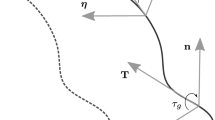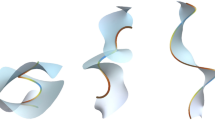Abstract
We study critical surfaces for a surface energy which contains the squared \(L^2\) norm of the difference of the mean curvature H and the spontaneous curvature \(c_o\), coupled to the elastic energy of the boundary curve. We investigate the existence of equilibria with \(H\equiv -c_o\). When \(c_o \geqslant 0\), we characterize those cases where the infimum of this energy is finite for topological annuli, and we find the minimizer in the cases that it exists. Results for topological disks are also given.




Similar content being viewed by others
References
Asgari, M., Biria, A.: Free energy of the edge of an open lipid bilayer based on the interactions of its constituent molecules. Int. J. Nonlinear Mech. 76, 135–143 (2015)
Babich, M., Bobenko, A.: Willmore tori with umbilic lines and minimal surfaces in hyperbolic space. Duke Math. J. 72, 141–185 (1993)
Brander, D., Dorfmeister, J.F.: The Björling problem for non-minimal constant mean curvature surfaces. Commun. Anal. Geom. 18–1, 171–194 (2010)
Biria, A., Fried, E.: Buckling of a soap film spanning a flexible loop resistant to bending and twisting. Proc. R. Soc. A 470, 20140368 (2014)
Biria, A., Fried, E.: Theoretical and experimental study of the stability of a soap film spanning a flexible loop. Int. J. Eng. Sci. 94, 86–102 (2015)
Biria, A., Maleki, M., Fried, E.: Continuum theory for the edge of an open lipid bilayer. Adv. Appl. Mech. 46, 1–68 (2013)
Boal, D.H., Rao, M.: Topology changes in fluid membranes. Phys. Rev. A 46, 3037 (1992)
Capovilla, R., Chryssomalakos, C., Guven, J.: Hamiltonians for curves. J. Phys. A: Math. Gen. 35, 6571–6587 (2002)
Capovilla, R., Guven, J., Santiago, J.: Lipid membranes with an edge. Phys. Rev. E 66, 021607 (2002)
Delaunay, C.: Sur la surface de revolution dont la courbure moyenne est constante. J. Math. Pures Appl. 16, 309–320 (1841)
Euler, L.: De Curvis Elasticis. In: Methodus Inveniendi Lineas Curvas Maximi Minimive Propietate Gaudentes, Sive Solutio Problematis Isoperimetrici Lattissimo Sensu Accepti, Additamentum 1 Ser. 1 24, Lausanne, (1744)
Gibaud, T., Kaplan, C.N., Sharma, P., Zakhary, M.J., Ward, A., Oldenbourg, R., Meyer, R.B., Kamien, R.D., Powers, T.R., Dogic, Z.: Achiral symmetry breaking and positive Gaussian modulus lead to scalloped colloidal membranes. Proc. Natl. Acad. Sci. USA 114–17, 3376–3384 (2017)
Giomi, L., Mahadevan, L.: Minimal surfaces bounded by elastic lines. Proc. R. Soc. A 468, 1851–1864 (2012)
Heinz, E.: Über die existenz einer flache konstanter mittlerer krummung bei vorgegebener berandung. Math. Ann. 127, 258–287 (1954)
Helfrich, W.: Elastic properties of lipid bilayers: theory and possible experiments. Zeit. Naturfor. C 28, 693–703 (1973)
Hildebrandt, S.: On the Plateau problem for surfaces of constant mean curvature. Commun. Pure Appl. Math. 23, 97–114 (1970)
Hopf, H.: Differential Geometry in the Large, Seminar Lectures New York University 1946 and Stanford University 1956, vol. 1000. Springer, New York (2003)
Langer, J., Singer, D.A.: Knotted elastic curves in \({\mathbb{R}}^3\). J. Lond. Math. Soc. (2) 30, 512–520 (1984)
Langer, J., Singer, D.A.: Lagrangian aspects of the Kirchhoff elastic rod. SIAM Rev. 38, 605–618 (1986)
Litherland, R.A.: Signatures of iterated torus knots. In: Fenn, R. (ed.) Topology of Low-Dimensional Manifolds. Lecture Notes in Mathematics, vol. 722. Springer, Berlin (1979)
Maleki, M., Fried, E.: Stability of discoidal high-density lipoprotein particles. Soft Matter 9–42, 9991–9998 (2013)
Mathematica Stack Exchange, https://mathematica.stackexchange.com/questions/72203/can-mathematica-solve-plateaus-problem-finding-a-minimal-surface-with-specifie
Morrey Jr., C.B.: Multiple Integrals in the Calculus of Variations. Springer, New York (2009)
Murasugi, K.: Knot Theory and Its Applications. Birkhäuser, Boston (1996)
Nitsche, J.C.: Stationary partitioning of convex bodies. Arch. Ration. Mech. Anal. 89–1, 1–19 (1985)
Palmer, B.: Uniqueness theorems for Willmore surfaces with fixed and free boundaries. Indiana Univ. Math. J. 49–4, 1581–1601 (2000)
Palmer, B., Pámpano, A.: Minimal surfaces with elastic and partially elastic boundary. Proc. A R. Soc. Edinb. https://doi.org/10.1017/prm.2020.56. (2020)
Patnaik, U.: Volume Constrained Douglas Problem and the Stability of Liquid Bridges between Two Coaxial Tubes, Dissertation, University of Toledo, USA (1994)
Rózycki, B., Lipowsky, R.: Spontaneous curvature of bilayer membranes from molecular simulations: asymmetric lipid densities and asymmetric adsorption. J. Chem. Phys. 142–5, 054101 (2015)
Tu, Z.C.: Compatibility between shape equation and boundary conditions of lipid membranes with free edges. J. Chem. Phys. 132–8, 084111 (2010)
Tu, Z.C.: Geometry of membranes. J. Geom. Symmetry Phys. 24, 45–75 (2011)
Tu, Z.C., Ou-Yang, Z.C.: A geometric theory on the elasticity of bio-membranes. J. Phys. A: Math. Gen. 37, 11407–11429 (2004)
Tu, Z.C., Ou-Yang, Z.C.: Lipid membranes with free edges. Phys. Rev. E 68, 061915 (2003)
Tu, Z.C., Ou-Yang, Z.C.: Recent theoretical advances in elasticity of membranes following Helfrich’s spontaneous curvature model. Adv. Colloid Interface Sci. 208, 66–75 (2014)
Walani, N., Torres, J., Agrawal, A.: Anisotropic spontaneous curvatures in lipid membranes. Phys. Rev. E 89–6, 062715 (2014)
Zhou, X.: An integral case of the axisymmetric shape equation of open vesicles with free edges. Int. J. Nonlinear Mech. 106, 25–28 (2018)
Acknowledgements
The second author has been partially supported by MINECO-FEDER grant PGC2018-098409-B-100, Gobierno Vasco grant IT1094-16 and by Programa Posdoctoral del Gobierno Vasco, 2018. He would also like to thank the Department of Mathematics and Statistics of Idaho State University for its warm hospitality.
Author information
Authors and Affiliations
Corresponding author
Additional information
Communicated by Eliot Fried.
Publisher's Note
Springer Nature remains neutral with regard to jurisdictional claims in published maps and institutional affiliations.
Appendix A: First Variation Formula
Appendix A: First Variation Formula
In this appendix, we will compute the first variation formula of the total energy E. Most of the calculations below are well known and they are included for completeness.
Let \(\delta X\) be a smooth \(\mathbf{R }^3\) valued map on \(\Sigma \) which we consider as a variation field, i.e., the linear term of a deformation \(X_\epsilon :=X+\epsilon \, \delta X+{\mathcal {O}}(\epsilon ^2)\).
Although for functionals with geometric character (i.e., invariant under changes of parameterization) only normal variations are usually considered, for surfaces with boundary it is essential to use variations having normal as well as tangential components. In general, the boundary is not invariant under tangential variations and, hence, computing the first variation formula only for normal variations leads to a loss of valuable information.
We decompose \(\delta X\) as \(V+\psi \nu \) with V tangent to the surface. At times we will denote with “dot” derivatives with respect to the variation parameter \(\epsilon \), i.e., \(\delta f={\dot{f}}\) for an \(\epsilon \) dependent function f on \(\Sigma \).
We first consider the case \(V\equiv 0\). A straightforward calculation gives the variation for the normal field as
where we denote the surface gradient operator by \(\nabla \).
We next compute the variation for the components metric tensor \(g_{ij}\) with respect to a locally defined frame field \(\{e_1, e_2\}\) which is orthonormal for the metric induced by \(X_0\equiv X\), i.e., \(g_{ij}(0)=\delta _{ij}\),
where \(L_{ij}:=-X_i\cdot \nu _j\) are the components of the second fundamental form of the surface. Recall that this tensor is symmetric, i.e., \(L_{ij}=L_{ji}\).
The induced surface measure on \(\Sigma \) is given by \(d\Sigma =g^{1/2}\left( e_1^*\wedge e_2^*\right) \), where \(g:=\det (g_{ij})\) and \(\{e_1^*,e_2^*\}\) is the dual basis. From this and the calculation above, one easily obtains
We now consider the variation for the second fundamental form of the surface \(\left( L_{ij}\right) \):
From the previous two calculations, we obtain, using \({\dot{g}}^{ij}=-{\dot{g}}_{ij}\),
where \(\Vert d\nu \Vert ^2=L_{ij}L_{ij}=4H^2-2K\) is the square of the norm of the second fundamental form.
In order to compute the pointwise variation for the Gaussian curvature K, we choose the frame so that, in addition to being orthonormal, \(L_{ij}=k_i\delta _{ij}\) holds. Here, \(k_1\) and \(k_2\) are the principal curvatures of the surface. Then we obtain
The Codazzi equations with respect to this frame are:
Define \(A:=\left( d\nu +2H\,Id\right) \nabla \psi = k_2\psi _{1}e_1+k_1\psi _{2}e_2\). Below we use the notation \(\psi _{i,j}\) to denote \(e_j(\psi _i)\) and as before \(\psi _{,ij}\) denotes the (i, j) component of the Hessian tensor. Using the Codazzi equations, we have that the divergence \(\nabla \cdot \) of A is given by
Comparing this with the expression for \({\dot{K}}\) above, we obtain
For the case of a variation tangential to the surface, i.e., \(\delta X=V\), it is clear that \({\dot{H}}=\nabla H\cdot V\), \(\dot{K}=\nabla K\cdot V\) and \(\delta d\Sigma =\left( \nabla \cdot V\right) d\Sigma \), where \(\nabla \cdot V\) denotes the divergence of V.
We are now in a position to compute the variation for the Helfrich energy ( Helfrich (1973))
For \(\delta X=\psi \nu +V\), integrating by parts we obtain
In the last line, we have used Green’s Second Identity.
Similarly, for \(\delta X=\psi \nu +V\) the variation for the total Gaussian curvature is given by
where in the third line we have used the Divergence Theorem.
Finally, to compute the first variation formula of the bending energy of the boundary we need to know the pointwise variation of the squared curvature. For an arbitrary parameter t, we have
since \({\dot{T}}=\left[ \left( {\dot{C}}\right) '\right] ^\perp \) and, hence, \(\left( {\dot{T}}\right) '=\left( {\dot{C}}\right) ''-T'\cdot \left( {\dot{C}}\right) '-T\cdot \left( {\dot{C}}\right) ''\). Next, from the induced measure on \(\partial \Sigma \), we directly obtain \(\delta (ds)=T\cdot \left( {\dot{C}}\right) 'ds\). Combining both things we get
where in the last equality we have integrated by parts.
The same variations have been obtained using different techniques in Biria et al. (2013) and Tu and Ou-Yang (2004), to mention a couple. For the boundary energy see also Appendix of Langer and Singer (1986).
Rights and permissions
About this article
Cite this article
Palmer, B., Pámpano, Á. Minimizing Configurations for Elastic Surface Energies with Elastic Boundaries. J Nonlinear Sci 31, 23 (2021). https://doi.org/10.1007/s00332-021-09679-4
Received:
Accepted:
Published:
DOI: https://doi.org/10.1007/s00332-021-09679-4




